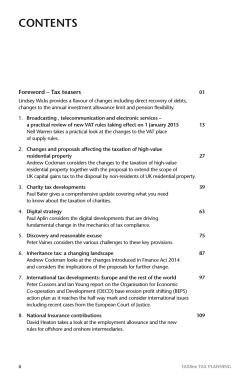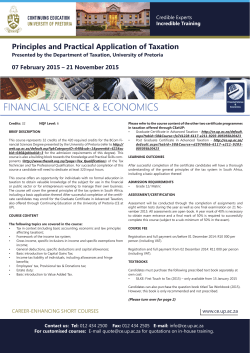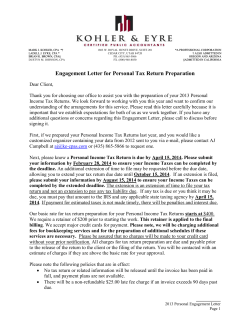
Lecture II Slides - University College London
Econ 3007 Economic Policy Analysis Reforming the Tax System Lecture II: The Taxation of Savings February 2015 Richard Blundell University College London Teaching Resources at: http://www.ucl.ac.uk/~uctp39a/lect.html http://www.ifs.org.uk/mirrleesReview The Taxation of Savings • • • • • Background readings (on moodle): Auerbach (2006) ‘The Choice between Income and Consumption Taxes: A Primer’, on website Banks and Diamond (2010), Mirrlees Review: Dimensions of Tax Design, on website Chapters 13 &14 of Mirrlees Review: Tax by Design Atkinson and Stiglitz (1976), Journal of Public Economics 6, pp55–75 ; UCL (electronic) library. Some Guiding Principles • • • • Individuals will have different preferences for saving and face different opportunities to engage in saving. In general, the tax system should be designed to enable choices to be based on trade-offs that reflect the underlying costs of moving productive resources across time – that is, the opportunities for real investment. Economic efficiency arguments suggest that the trade-off individuals and households face for consuming tomorrow rather than today should reflect the return to investment in productive capacity in the economy The marginal rate of transformation of consumer goods – the real interest rate. Implications • On this basis the tax system should allow individuals to make their consumption decisions in a way that reflects the true cost of the use productive resources over time – between current consumption and investment. • If we define the normal return to be the return on a safe investment, then the normal return reflects this trade-off. Taxing (or subsidizing) the normal return will distort the trade-off and is generally unwise. Guiding Principles for the Taxation of Savings • As a counter-example - if the decision to delay consumption tells us about an individual’s earning capacity (e.g. it may be that clever people are patient), then taxing savers may be a useful ‘tag’ enabling us to tax high-ability people with less distortion to labour supply. • Remember in a Mirrlees tax model the government cannot observe true ability and can only tax income – from earnings and from savings. – If savings indicates a high ability – high life-time earnings potential – person, then taxing the return to savings may be optimal - that is high ability types are more patient. – It may also be that savings and labour supply are directly linked. Guiding Principles for the Taxation of Savings • A good place to start considering this class of models is the Atkinson-Stiglitz theorem (1976, Journal of Public Economics 6, 55–75 ) which states: – • 1. 2. when the available tax tools include nonlinear earnings taxes, differential taxation of first- and second-period consumption is not optimal if two key conditions are satisfied: all consumers have preferences that are separable between consumption and labour, and all consumers have the same (sub)utility function of consumption. The Atkinson Stiglitz Result • Model with two periods t=1 and t=2, with no uncertainty. • Individual gets labor income YL = w.h at t =1 (w = wage rate, h = labor supply), and chooses how much to consume c1 and c2 • Max U(C1,C2) – V(h) – under budget constraint: C1 + C2/(1+r) = YL • Period 1 savings S = YL - C1 • Period 2 capital income Yk = (1+r)S = C2 • r = rate of return (= marginal product of capital FK with production function F(K,L)) • >>> taxing capital income Yk is like taxing the relative price of period 2 consumption C2 The Atkinson Stiglitz Result • Atkinson-Stiglitz: under separable preferences U(C1,C2)V(h), there is no point taxing capital income; it is more efficient to redistribute income by using solely a labor income tax t(YL) • With non-separable preferences U(C1,C2,h), it might make sense to tax less the goods that are more complement with labor supply (say, tax less day care or baby sitters, and tax more vacations); but note this requires a lot of information on cross-derivatives. • If second period leisure time is more complementary with consumption then it may make sense to tax capital income. Guiding Principles for the Taxation of Savings • • • • • • Returning to the conditions (can be somewhat relaxed): The first condition states that the marginal benefit derived from consumption over the life-time should not depend on labour supply. The second requires all consumers to be similar in their desire to smooth consumption across their life-cycle and across potentially uncertain states of the world. The theorem refers to not “differentially taxing first- and second-period consumptions.” That is, a tax on consumption that is the same in both periods. With no uncertainty and borrowing at the safe rate this is equivalent to exempting interest income from taxation. Guiding Principles for the Taxation of Savings • • 1. 2. It is differential tax rates that matter for efficiency by introducing a “wedge” between the intertemporal marginal rate of substitution (MRS) and the intertemporal marginal rate of transformation (MRT) between consumer goods in different periods. Two ways of having differential taxation of consumption in the two periods are: through different tax rates on consumption in the two periods and through taxation of the capital income that is received as part of financing second-period consumption out of firstperiod earnings. Guiding Principles for the Taxation of Savings • • That is, if taxes should not distort the timing of consumption (if the MRS should equal the MRT), then the optimum is not consistent with taxing these consumer goods other than with equal rates, and thus inconsistent with taxing saving at the margin. The theorem extends to having multiple periods of consumption. A Simple Two-Period Model without Uncertainty • • • • Consider a two period model in which an individual receives a fixed income Y1 (endowment) in period 1 and allocates this between consumption C1 and C2 in periods 1 and 2 respectively. Savings Y1-C1 earn a known rate of return r, with the full payout consumed in period 2. All individuals can borrow or lend at this risk-free interest rate, which is determined outside the model (perfect capital market; small open economy). The individual cares only about consumption, and discounts period 2 utility at the discount rate ρ (rate of time preference). A Two-Period Model without Uncertainty • In the absence of any tax, the individual chooses C1 to maximise 1 U C2 V U C1 1 subject to C2 = (1+r)(Y1-C1) with Y1 fixed. A Two-Period Model without Uncertainty • Writing 1 U (1 r )(Y1 C1 ) V U C1 1 • we obtain the familiar Euler equation for the intertemporal allocation of consumption U C V U 1 r U 1 r 1 0 . C1 C1 1 C 2 U 1 C 2 Pure Income Tax • • A tax on income at the constant rate t implies tax payments of tY1 on the endowment income in period 1, and tr[(1-t)Y1-C1] on the interest income in the second period. The budget constraint becomes C2 = (1+(1-t)r)[(1-t)Y1C1] and the first order condition becomes: U C V U 1 (1 t )r U 1 (1 t )r 1 0 C1 C1 1 C 2 1 U C 2 • indicating that, by lowering the rate of return, the tax on capital income distorts the inter-temporal allocation of consumption. Pure Consumption Tax • Consumption Ci in each period ‘i’ is taxed at the constant rate τ, so that a consumption of Ci requires an outlay of Oi = Ci + τ Ci = Ci(1+ τ). Savings are now Y1-O1, generating an outlay in period 2 of O2 = (1+r)(Y1-O1) and consumption in period 2 of C2 = O2/(1+ τ). • The first order condition becomes: U 1 r C V 1 U 1 r U 1 0 O1 1 C1 1 C 2 U 1 C 2 • indicating that a tax on consumption levied at a constant rate does not distort the inter-temporal allocation. Income Tax with Interest Exemption • • • An income tax that exempts interest income implies a tax payment of tY1 on the endowment income in period 1 only. This a lump sum tax that does not depend on the individual’s consumption choice. The budget constraint is now C2 = (1+r)[(1-t)Y1-C1] and the first order condition is again U 1 r C V U 1 r U 1 0 C1 C1 1 C 2 U 1 C 2 and, as expected, there is no distortion to the intertemporal consumption decision – equivalent to consumption tax in this setting. Uncertain Returns • • • • • Income Tax with Exemption for the Risk-free Rate of Return on Assets Income from capital is now taxed in period 2 at rate t, with an exemption for the risk-free rate of return on assets. Income from the safe asset is thus not taxed. If the risky asset pays the high rate of return, there is a tax charge of t(rH - rf) on each unit held. Symmetrically, if the risky asset pays the low rate of return, there is a tax rebate of t(rL - rf) on each unit held. Exercise: Show this is equivalent to a consumption tax. Key Arguments for Taxing the Return to Saving Rents: • If returns to saving represents pure rents, for example on a holding of land or a monopoly ownership of some resource, then income from savings should be taxed. • But by how much? • Notice with uncertainty we only exempt tax on the ‘normal’ return on a safe asset, that is the risk free return. • Excess returns above this are taxed. • Consequently rents are captured as excess returns when an allowance for interest payments at the safe rate is made. Key Arguments for Taxing the Normal Return to Saving Impatience and cognitive ability: • In experimental psychology there seems to be wide acceptance that higher ability individuals are more patient. • This gives the high-skill consumers a relatively stronger preference for consumption in the second period of life, and therefore the high-skill save more as a proportion of income than the low-skill. – see arguments in Banks and Diamond (Mirrlees Review – in moodle) Key Arguments for Taxing the Normal Return to Saving Impatience and cognitive ability: • If the rate of discount varies in a predictable way with productive ability then this give rise to an optimal tax on the return to risk-free saving. The tax on second-period consumption can be achieved by taxing observed saving, and this will implicitly tax the high-ability types. • – For example, for further reading see Capital Income Taxes with Heterogeneous Discount Rates (Johannes Spinnewijn and Peter Diamond) - AEJ: Economic Policy 3(4), November 2011 Key Arguments for Taxing the Normal Return to Saving Uncertain earnings ability/individual productivity: • Suppose an individual is uncertain about his or her ability (productivity) next period – They will tend to save ‘too much’. • That is they will save because they worry they maybe low ability (have low productivity) next period • If they to have high ability/high productivity they will have saved ‘too much’ and consequently will not work so much. Less than optimal for a high ability/productivity worker. – In this case a positive tax on the return to capital/taxation of saving can be optimal – see the discussion of uncertain earnings, – see section 1, page 18 in Banks and Diamond (moodle).
© Copyright 2025













